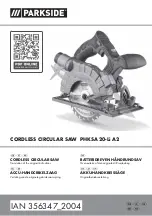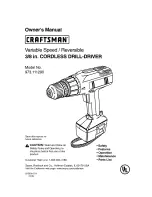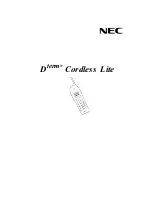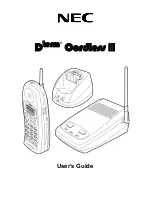
19
First, unplug the tool. Loosen all the screws (2 each on
left and right) securing the kerf boards. Re-tighten them
only to the extent that the kerf boards can still be easily
moved by hand. Lower the handle fully and push in the
stopper pin to lock the handle in the lowered position.
Loosen two clamp screws which secure the slide poles.
Pull the carriage toward you fully. Adjust the kerf boards
so that the kerf boards just contact the sides of the blade
teeth. Tighten the front screws (do not tighten firmly).
Push the carriage toward the guide fence fully and adjust
the kerf boards so that the kerf boards just contact the
sides of blade teeth. Tighten the rear screws (do not
tighten firmly).
After adjusting the kerf boards, release the stopper pin
and raise the handle. Then tighten all the screws
securely.
CAUTION:
• Before and after changing the bevel angle, always
adjust the kerf boards as described above.
Maintaining maximum cutting capacity
(Fig. 10 & 11)
This tool is factory adjusted to provide the maximum
cutting capacity for a 190 mm saw blade.
When installing a new blade, always check the lower limit
position of the blade and if necessary, adjust it as follows:
First, unplug the tool. Push the carriage toward the guide
fence fully and lower the handle completely. Use the hex
wrench to turn the adjusting bolt until the periphery of the
blade extends slightly below the top surface of the turn
base at the point where the front face of the guide fence
meets the top surface of the turn base.
With the tool unplugged, rotate the blade by hand while
holding the handle all the way down to be sure that the
blade does not contact any part of the lower base. Re-
adjust slightly, if necessary.
WARNING:
• After installing a new blade, always be sure that the
blade does not contact any part of the lower base when
the handle is lowered completely. Always do this with
the tool unplugged.
Stopper arm (Fig. 12)
The lower limit position of the blade can be easily
adjusted with the stopper arm. To adjust it, move the
stopper arm in the direction of the arrow as shown in the
figure. Adjust the adjusting screw so that the blade stops
at the desired position when lowering the handle fully.
Sub-fence (Fig. 13)
Country specific
WARNING:
•
When performing left bevel cuts, flip the sub-fence
outward.
Otherwise, it may contact the blade or a part
of the tool, and may result in serious injury to the
operator.
This tool is equipped with the sub-fence. Usually position
the sub-fence inside. However, when performing left
bevel cuts, flip it outward.
Adjusting the miter angle (Fig. 14)
Loosen the grip by turning counterclockwise. Turn the
turn base while pressing down the lock lever. When you
have moved the grip to the position where the pointer
points to the desired angle on the miter scale, securely
tighten the grip clockwise.
CAUTION:
• When turning the turn base, be sure to raise the handle
fully.
• After changing the miter angle, always secure the turn
base by tightening the grip firmly.
Adjusting the bevel angle (Fig. 15 & 16)
To adjust the bevel angle, loosen the lever at the rear of
the tool counterclockwise.
Push the handle to the left to tilt the saw blade until the
pointer points to the desired angle on the bevel scale.
Then tighten the lever clockwise firmly to secure the arm.
To tilt the blade to the right, push the release button at
the rear of the tool while tilting the blade slightly to the left
after loosening the lever. With the release button
depressed, tilt the saw blade to the right.
CAUTION:
• When tilting the saw blade, be sure to raise the handle
fully.
• After changing the bevel angle, always secure the arm
by tightening the lever clockwise.
• When changing bevel angles, be sure to position the
kerf boards appropriately as explained in the
“Positioning kerf board” section.
Adjusting the lever position (Fig. 17)
The lever can be repositioned at every angle 30° when
the lever does not provide full tightening.
Loosen and remove the screw that secures the lever at
the rear of the tool. Remove the lever and install it again
so that it is slightly above the level. Secure the lever with
the screw firmly.
Switch action (Fig. 18)
WARNING:
•
Before plugging in the tool, always check to see
that the switch trigger actuates properly and
returns to the “OFF” position when released. Do
not pull the switch trigger hard without pressing in
the lock-off button. This can cause switch
breakage.
Operating a tool with a switch that does not
actuate properly can lead to loss of control and serious
personal injury.
•
NEVER use tool without a fully operative switch
trigger.
Any tool with an inoperative switch is HIGHLY
DANGEROUS and must be repaired before further
usage or serious personal injury may occur.
•
NEVER defeat the lock-off button by taping down
or some other means.
A switch with a negated lock-
off button may result in unintentional operation and
serious personal injury.
•
NEVER use the tool if it runs when you simply pull
the switch trigger without pressing the lock-off
button.
A switch in need of repair may result in
unintentional operation and serious personal injury.
Return tool to a Makita service center for proper repairs
BEFORE further usage.
To prevent the switch trigger from being accidentally
pulled, a lock-off button is provided. To start the tool,
press in the lock-off button and pull the switch trigger.
Release the switch trigger to stop.
A hole is provided in the switch trigger for insertion of a
padlock to lock the tool off.
Содержание LS0714
Страница 7: ...7 41 42 43 44 45 52 38 45 45 45 45 67 68 69 002246 1083010 1083009 1083014 001555 5 66 5 66 5 65 5 ...
Страница 142: ...142 ...
Страница 143: ...143 ...
















































